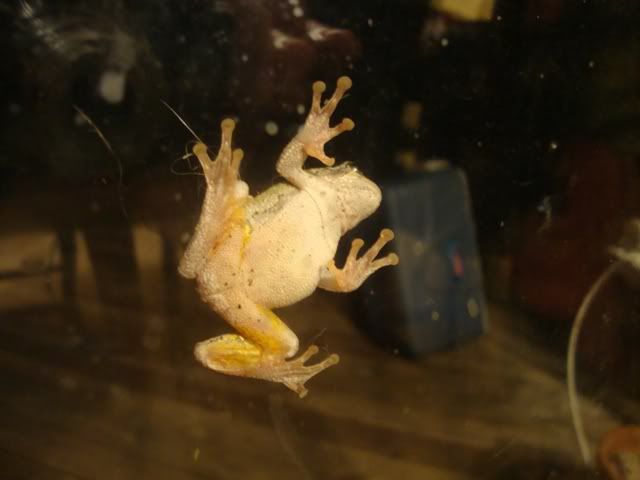We've seen Gray Treefrogs (Hyla versicolor) around the house on many occassions since arriving in the upper Midwest.
On our first day in the new place, I stepped out on the back porch to look at the air conditioning unit and saw one sitting on the deck. I grabbed the little frog, and much to my daughter's delight, brought it in for her to see.
After that, encountering them became an almost daily occurrence. Once, I opened the umbrella over our patio table and a little treefrog fell out. On another occassion, I lifted up a watering can to find one of the little critters hiding beneath. They also frequently end up on our sliding glass patio doors hunting insects at night. On many nights, I've glanced over while banging away on the computer to see one of these little predators deftly ambushing moths that are attracted to the light shinning through. They pay little attention to me, even when I stand and scrutinize them closely through the glass. I vividly recall seeing them on the windows of my grandparents' house as a kid doing the exact same thing as I watch them doing now. Perhaps I associate fond childhood memories with this species, which "ups the cool ante" on them.
Even as I type this entry, I'm watching one maneuver his way around the transparent dinner table that is our patio door. I've seen him miss one moth and nab another so far. And all with the typical panache that this little amphibian exhudes every time I see one. They seem to have personality to burn, if one were to anthropomorphize.
I know they must be generally successful at hunting around our place, for I frequently find their scat, filled with chitinous insect parts and stuck to the the walls and windows. The numbers of insects one individual treefrog consumes in a summer must be substantial.
I'm thrilled to see this species. It's one of my favorites. I've posted about my encounters in North Carolina with a very closely related species: the Cope's Gray Treefrog (Hyla chrysoscelis; see here and here).
I hope they hang around my windows for many years to come.

Having never lived someplace with lots of amphibians or reptiles, I'm always amazed at the concept of a "tree" frog. Very cool. I love that last photo. Does anyone know how they hang onto vertical surfaces? I know the gecko story about how their toes adhere to surfaces (my colleague discovered that). I wonder if it's the same for the tree frogs?
ReplyDeleteI hope that you see them for decades to come!
Hey KB....
ReplyDeleteThe mechanism treefrogs use is a tad different than geckos.
The pads on each toe of a treefrog is a series of many hexagonal cells with crevices in between. These fill with a mucous that helps create adhesion. The flatter parts of the hexagonal cells apparently also have little pillar shaped papillae with an indentation on the tip that, with the aid of mucous, create friction against the surface they are clinging too and further increases their ability to adhere.
Don't know if I'm describing that very well or not....
I hope they keep coming back too! They have been there every night lately...even as I type this comment, there is one hanging on the patio doors to my left, hunting moths.
Love this! We've got the cute-as-the-dickens little Pacific tree frog here in the Pacific Northwest (Hyla regilla or Pseudacris regilla, depending on who you talk to). Because their range extends down to Hollywood, this is the frog sound recorded and used in movies...regardless of where in the world the movie's setting is...
ReplyDelete--Patricia Lichen
http://www.patriciaklichen.com/
Hi Patricia!
ReplyDeleteI know the Pacific treefrog well! Raised some from tadpoles that were left-overs from some lab research I was involved with as an undergrad.
Cute little buggers. They are more along the lines of our Chorus Frogs and Spring Peepers (both smaller and also in the genus Pseudacris). The Gray Treefrog is quite a bit bigger....not as big as some of the southern treefrog species...but pretty big regardless.
Thanks for reading!
BTW...another commonly heard critter in movie backgrounds (particularly old black and white movies) is a Wisconsin bird called the Common Loon. It has an eerie call, which meant it ended up in any movie with an exotic and/or sinister jungle setting!
We wont even talk about all the milksnakes that get screamed at on-screen as part of Hollywood's determination to make us think they are coral snakes.... ;)